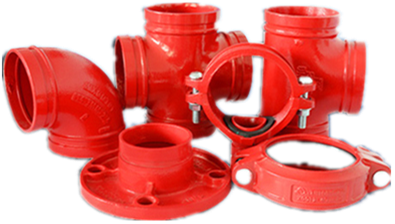Types of Dry Barrel Fire Hydrant
Dry barrel hydrants get their name from the fact that water is drained or pumped from the barrel when the hydrant is not in use. Dry barrel hydrants are pressurized and drained through the workings of a main valve located in the base of the hydrant. When the main valve is opened, the barrel is pressurized; when the main valve is closed the barrel drains. This type of hydrant may be used almost anywhere, but is especially suited to areas where freezing weather occurs.
In a dry barrel hydrant, a single main valve is located in the base of the hydrant adjacent to the inlet connection. In addition, the dry barrel hydrant is equipped with an automatically operated drain valve. When the main valve is closed, the drain valve automatically opens, draining all water from the barrel of the hydrant. When the hydrant is opened, the drain valve automatically closes. The main valve is located below the normal frost line to protect the hydrant from freezing. This allows the dry barrel hydrant to be used almost anywhere. Three variations of dry barrel hydrants are defined below.
Compression Type. In this type of hydrant, the main valve moves reciprocally on a vertical axis against a seat located in the hydrant base. The valve moves against the sear to close and away from the seat to open. It is moved by a vertical stem; the stem moves up or down when the operated nut is rotated. The valve may be located below the seat and open against the pressure or above the seat and open with the pressure.
Toggle Type. In this type of hydrant, the main valve moves reciprocally on a horizontal axis against or away from a vertical seat located in the base of the hydrant . The main valve is moved by means of a vertical stem that has left hand and right hand threads. Rotation of the stem causes the arms of the toggle mechanism to move the main valve. The valve always moves away from the seat to open and against the seat to close.
Slide-gate type. In this type of hydrant, the main valve consists of a gate that moves vertically by means of a threaded stem. When the stem is rotated, it causes the internally threaded gate to move. The gate is forced against the valve seat by a wedging mechanism. The valve seat is installed in the base of the hydrant .
Other Hydrants
High pressure hydrants. High pressure hydrants are designed and constructed for working pressures above 150 psig. These hydrants are not within the scope of AWWA C502 or AWWA C503. One design of high pressure hydrant is the high pressure pilot-valve hydrant. Other high pressure hydrants in the United States are similar to standard hydrants but are strengthened in materials and design.
High pressure pilot-valve hydrants. These hydrants differ from other high pressure hydrants in the design of the main valve. There is a small valve, or pilot valve, in the center of the main valve. The pilot calve opens before and in tandem with the main valve, equalizing pressure on both sides of the main valve with a controlled volume of water. This reduces operating torque in high-pressure applications, which makes the main valve easier to open. The pilot valve also greatly reduces the potential of hydrant vibration or chatter.

